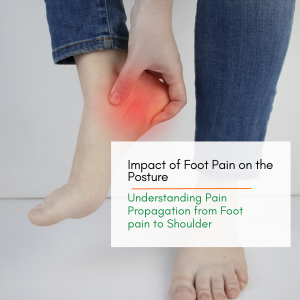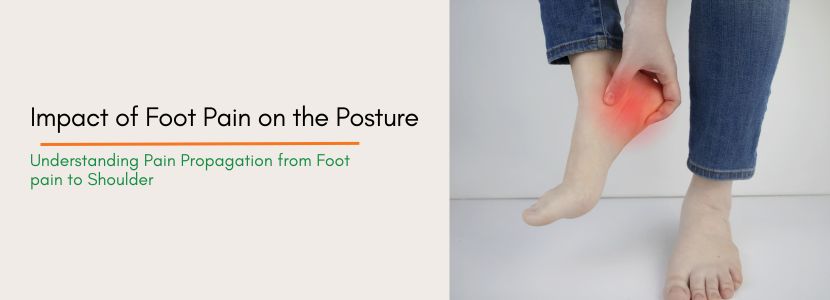The Impact of Foot Pain on Posture: Understanding Pain Propagation from Foot to Shoulder


Read Time: 15mins Language: English
Foot pain is a common complaint that can have far-reaching effects on our overall well-being. Beyond the immediate discomfort, foot pain can significantly impact our posture, leading to a chain reaction of pain propagation throughout the body. In this blog, we will explore the intricate relationship between foot pain and posture, specifically focusing on how pain can radiate from the foot to the knee, hip, spine, neck, and shoulder. Understanding this pain propagation pathway is crucial for addressing foot pain and maintaining optimal posture.
Foot Pain and Its Connection to Posture:
Altered Weight Distribution: When experiencing foot pain, individuals may unknowingly alter their weight distribution to relieve pressure on the affected foot. This compensation can lead to imbalances in the body’s alignment, affecting posture.
Changes in Gait Pattern: Foot pain can alter a person’s natural gait pattern. Individuals may limp, favor one side, or modify their stride to minimize discomfort. These changes can disrupt the body’s overall alignment, leading to postural issues.
Muscle Imbalances: Foot pain can cause compensatory muscle imbalances. Muscles that are overused or underused due to altered gait or weight distribution can weaken or tighten, affecting the stability and alignment of the joints throughout the body.
Pain Propagation Pathway:
Foot to Knee:
a. Compensatory Movement: Foot pain can lead to altered movement patterns, placing additional stress on the knee joint. This can result in conditions such as patellofemoral pain syndrome or iliotibial band syndrome.
b. Joint Misalignment: Imbalances in foot mechanics can cause misalignment in the knee joint, leading to conditions like patellar tracking disorder or meniscus injuries.
Knee to Hip:
a. Hip Abnormalities: Altered gait patterns and imbalances originating from foot and knee pain can lead to hip joint abnormalities, including hip bursitis, hip labral tears, or hip osteoarthritis.
b. Pelvic Tilt and Instability: The compensation for foot and knee pain can cause an anterior or posterior pelvic tilt, disrupting the alignment of the hip joints. This can result in muscle imbalances, hip flexor strains, or hip impingement.
Hip to Spine:
a. Lumbar Spine Stress: Imbalances originating from foot and hip pain can affect the alignment and stability of the lumbar spine. This can lead to conditions such as herniated discs, sciatica, or chronic low back pain.
b. Spinal Curvature Changes: Compensatory movements can cause changes in spinal curvature, including increased lordosis (swayback) or kyphosis (rounding of the upper back), impacting posture and spinal health.
Spine to Neck:
a. Cervical Misalignment: Imbalances in the spine can affect the alignment and stability of the cervical spine. This can lead to conditions like cervical radiculopathy, cervical facet joint dysfunction, or tension headaches.
b. Forward Head Posture: Altered spinal alignment can contribute to forward head posture, where the head protrudes forward from the neutral position. This can cause strain on the neck muscles, resulting in neck pain, stiffness, and reduced range of motion.
Neck to Shoulder:
a. Shoulder Impingement: Forward head posture and imbalances in the neck can affect the positioning of the shoulder joint, leading to impingement syndrome, rotator cuff injuries, or frozen shoulder.
b. Upper Trapezius Tension: Tension and tightness in the upper trapezius muscles, often associated with poor posture, can radiate pain into the neck and shoulders, causing discomfort and limited mobility.
Addressing Foot Pain and Restoring Posture:
Consult a Healthcare Professional: If you experience foot pain or notice postural changes, it is essential to consult a healthcare professional, such as a podiatrist or physical therapist. They can evaluate your foot mechanics, gait pattern, and posture to determine the underlying cause of your pain and provide appropriate treatment recommendations.
Footwear and Orthotics: Wearing properly fitting shoes with adequate arch support and cushioning can help alleviate foot pain and promote better posture. In some cases, customized orthotic inserts may be recommended to correct imbalances and provide additional support.
Physical Therapy and Exercise:
a. Foot and Ankle Strengthening: Specific exercises and stretches can help strengthen the muscles in the feet and ankles, improving stability and reducing pain. You can download our free Guide ” 15mins to happy feet” to learn and repeat the exercises and stretches.
b. Core and Postural Exercises: Strengthening the core muscles and focusing on posture-related exercises can enhance overall body alignment and stability.Ergonomics and Postural Awareness:a. Workplace Ergonomics: Ensure that your workspace is ergonomically designed to promote good posture, with an appropriate chair, desk, and computer setup.
b. Mindful Posture: Maintain awareness of your posture throughout the day, making conscious efforts to sit and stand tall, aligning your spine, shoulders, and hips.
Massage and Manual Therapy: Seeking massage therapy or manual therapy from a qualified professional can help relieve muscle tension, promote circulation, and restore proper alignment.
Foot pain can have a significant impact on posture, leading to pain propagation from the foot to the knee, hip, spine, neck, and shoulder. Understanding this interconnected relationship is crucial for addressing foot pain and maintaining optimal posture. By seeking professional guidance, wearing proper footwear, engaging in targeted exercises, practicing good ergonomics, and maintaining postural awareness, we can address foot pain, restore balance, and promote overall musculoskeletal health. Prioritizing foot health and maintaining proper posture will not only alleviate pain but also contribute to improved mobility, comfort, and overall well-being.
At Care Catalyst, we record your Gait , Arch type, leg length difference and provide with customised footwear if required. You can Book an appointment to know your posture better so that you can start taking action.

